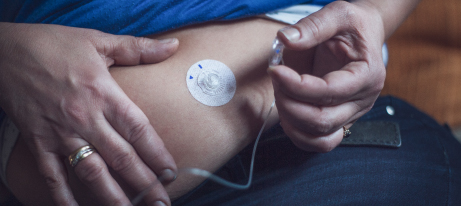
Branimir76 / iStock
Under the right circumstances, self-monitoring with continuous glucose monitoring (CGM) can inform care for patients on intense insulin regimens. The American Diabetes Association (ADA) made this key recommendation and others regarding CGM and automated insulin delivery systems in an update to its Standards of Medical Care.
Developed by ADA’s Professional Practice Committee, the revised recommendations in the Annals of Internal Medicine reflect new clinical evidence as well as feedback from the clinical community on devices, hardware, and software that individuals living with diabetes use to help manage blood glucose levels. “As technology surrounding continuous glucose monitoring evolves, CGM has the opportunity to positively impact the future of diabetes care and research, and establishing standard, official time-in-range recommendations is necessary for the clinical care, regulatory oversight, and research efforts related to CGM,” William T. Cefalu, MD ADA’s chief scientific, medical, and mission officer, said in a statement.
The update contains new language in the guidance’s section on diabetes technology.
For patients undergoing intensive insulin regimens such as insulin pump therapy or multiple daily injections, ADA outlines when self-monitoring of blood glucose (SMBG) or CGM should take place. Specifically, patients should assess their glucose levels before certain activities such as meals and snacks, driving, at bedtime, or exercising. Monitoring might also occur postprandially on occasion or when patients suspect they have low blood glucose. Individuals with diabetes also should do an assessment after treating low blood glucose until glycemic levels return to normal. SMBG or CGM “is most important for insulin-treated patients because it enables them to adjust therapy to minimize hypoglycemia and manage hyperglycemia,” wrote the authors, citing an observational study that showed an association between lower HbA1c levels and higher daily occurrence of SMBG among 27,000 youths.
SMBG may also help inform and educate patients who have infrequent insulin injections, the guidance authors offered.
Adult patients requiring constant glucose testing could use an intermittently scanned CGM as a substitute for SMBG, although this was only a “C” rated recommendation.
ADA also gave the green light on certain CGM and automated insulin delivery devices across age groups.
“Sensor-augmented pump therapy can be considered for children, adolescents, and adults to improve glycemic control without increasing overall or severe hypoglycemia,” the authors wrote of CGM devices.
The panel recommends the following glucose management metrics:
- Average glucose level;
- Percentage of time in hypoglycemia ranges <3.00 mmol/L [<54 mg/dL] and 3.00 to 3.89 mmol/L [54 to 70 mg/dL]);
- Percentage of time in the target range (3.89 to 10.0 mmol/L [70 to 180 mg/dL]); and
- Percentage of time in the hyperglycemia range (>10.0 mmol/L [>180 mg/dL]).
ADA also made some recommendations on real-time CGM in adults. “When used properly, real-time CGM in conjunction with intensive insulin regimens is a useful tool to lower HbA1c levels in adults with type 1 diabetes who are not meeting glycemic targets,” the panelists indicated. It may also serve as a useful tool in individuals experiencing frequent hypoglycemic episodes or who aren’t aware that they are experiencing hypoglycemia.
Patients should conduct real-time CGM at least once a day to derive the most benefit from the technology.
To prevent hypoglycemia episodes in adults with type 1 diabetes, the authors suggested using a sensor-augmented pump therapy with automatic low-glucose suspend. Approved by the Food and Drug Administration, this technology can “suspend basal insulin when glucose is currently low or predicted to decrease below 3.89 mmol/L (70 mg/dL) in the next 30 minutes,” they summarized.
The panel also recommended automated insulin delivery systems for managing glycemia in children age 7 or older, and in adults. According to the authors, “recent studies suggest that these systems may have psychosocial benefits and may reduce exercise-induced hypoglycemia.”